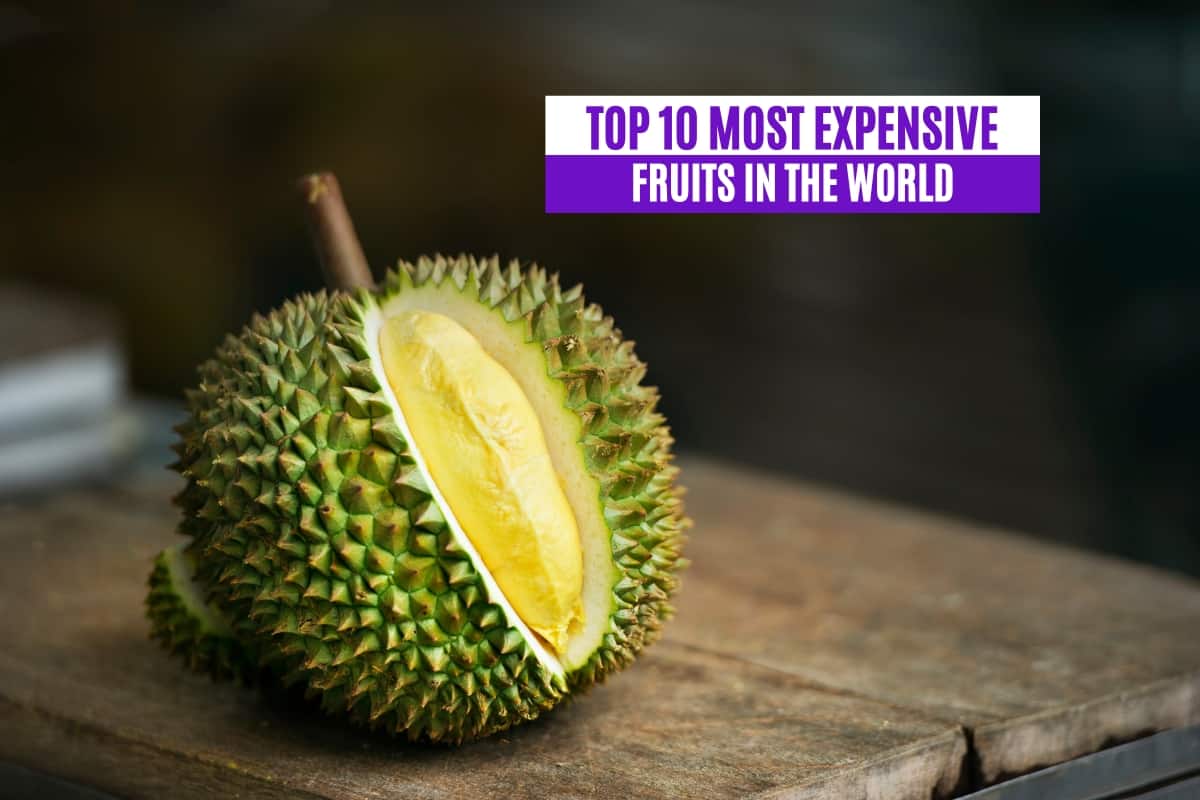Fresh fruit can be pretty pricey, especially when it’s organic or out of season. But while the average piece of fruit at your local grocery store might only cost a few bucks, some fruits cost thousands of dollars. Have you ever wondered about the most expensive fruits in the world?
The most expensive fruit in the world is the rare Kanyao Durian. Each of these greenish-yellow fruits costs $47,990. Although durian fruit is often considered an acquired taste due to its pungent scent, Kanyao (also spelled Kan Yao) Durian is a delicacy because of its rarity and reputation.
This ranking will reveal which fruits sell for the highest prices. We’ll also discuss why these delectable bits of produce are so incredibly costly!
Here Are the Top 10 Most Expensive Fruits in the World:
- Rare Kanyao Durian – $47,990 Each
- Yubari King Melon – $45,500 Per Pair
- Premium Hokkaido Cantaloupe – $27,240 Per Pair
- Ruby Roman Grapes – $11,000 Per Bunch
- Tenka-Fubu Branded Persimmon – $7,500 Per Pair
- Black Densuke Watermelon – $6,100 Each
- Taiyo no Tamago Mango – $3,725 Per Pair
- Lost Gardens of Heligan Pineapple – $1,200 Each
- Aomori Heartbeat Cherry – $296 Each
- Zentsuji Square Watermelon – $200 Each
10. Zentsuji Square Watermelon – $200 Each
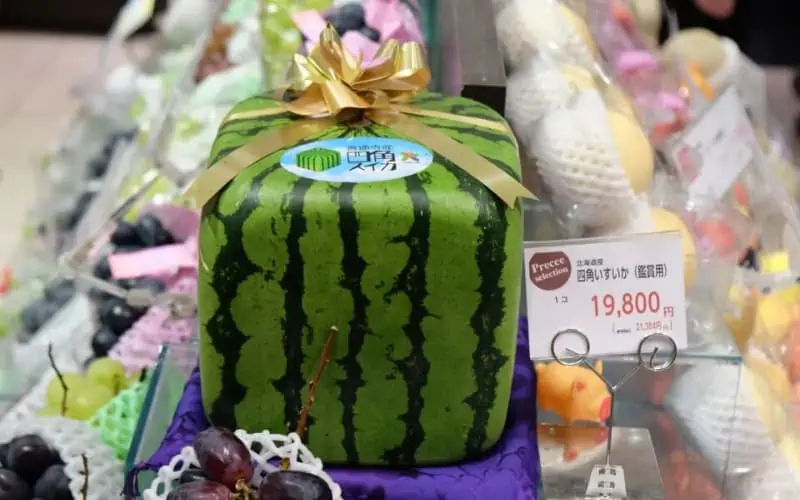
Watermelon is a common summertime snack, and its round shape and sweet pink flesh are instantly recognizable by most. But since the late 1970s, some watermelons in Japan have taken on a very different look!
The Zentsuji Square Watermelon is exactly what it sounds like. It’s a watermelon that’s square instead of round!
These fruits are grown in square boxes. So, as they continue developing, they push against the sides of their containers, giving them their distinct edges.
This shape makes them a convenient alternative to round watermelons, as they can easily fit and sit inside refrigerators. When they reach the “ideal” size of 7in by 7in (18cm by 18cm).
The Zentsuji Square Watermelon is one of Kagawa Prefecture’s top exports, as many international buyers are intrigued by the novelty and uniqueness of these box-shaped melons. But if you’d like to buy one of these cube-shaped watermelons for yourself, you’ll need to spend $200 per melon.
That doesn’t include shipping costs. Some buyers spend nearly a thousand bucks on a single watermelon.
It’s also worth noting that many of these square watermelons aren’t edible. Because they’re so small, most are unripe when they’re released from their box containers and sold.
Why Is It So Expensive?
Intensive labor and quality control are the primary reasons why the Zentsuji Square Watermelon is such an expensive piece of fruit. After all, these watermelons are mostly ornamental, so their exterior appearance is of utmost importance.
If these watermelons develop scratches, don’t have perfectly vertical and symmetrical stripes, or aren’t the right size, they’re immediately discarded. As you can imagine, achieving the ideal look with every single watermelon is challenging and requires a lot of care.
Of course, demand also plays a part in pricing. These watermelons hail from only one part of Japan, and annual yields fluctuate due to weather conditions. Low-yield years often make for much higher prices, as the supply of square watermelons falls far below the demand.
9. Aomori Heartbeat Cherry – $296 Each
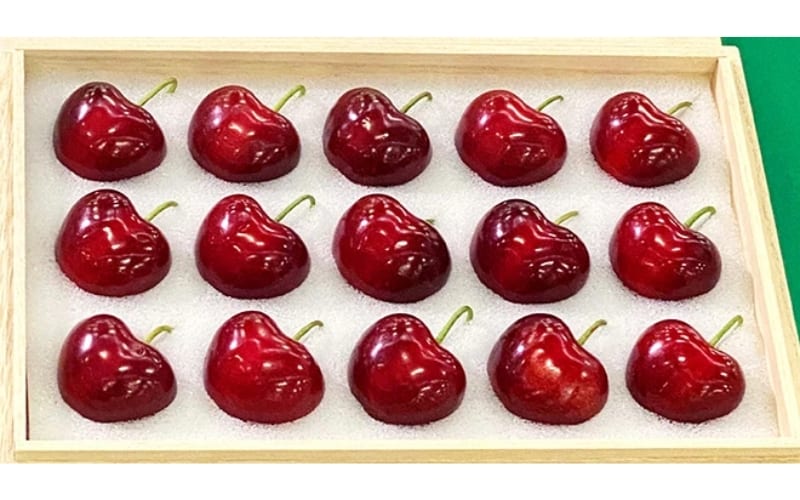
The average jar of maraschino cherries might only cost a few dollars, but if you’re looking to enjoy the best fresh cherries, you might want to visit the Aomori Prefecture in Japan. That’s because this region has specialized in creating some of the sweetest tasting (and looking) cherries, called the Aomori Heartbeat Cherry (also called the Juno Heart cherry).
These cherries get their name from their heart shape and their origin location. They’re exceptionally glossy and large, making them much more eye-catching than standard syrup-covered cherries or fresh cherries found at your local grocery store.
But because they’re special and sought-after, you might have to pay a high premium to taste one of these ruby-red cherries for yourself. After all, in June 2022, just one of these cherries sold for $296 (about ¥40,000)!
Naturally, those who live outside of Japan will have to pay a much higher price to try one of these cherries, as they’re typically only sold via auction. Consequently, the cost of trying an Aomori Heartbeat Cherry could easily climb into the thousands when you account for travel and accommodation costs.
Why Is It So Expensive?
Many sweet fruits like Sugarbee Apples are expensive, but most can’t compete with the price of the Aomori Heartbeat Cherry. After all, this type of cherry only grows in one place (the Aomori Prefecture) and is beloved due to its unusual size, sugar content, and iconic heart shape.
Because they’re comparatively rare (and demand remains high), the auction prices of these shiny red fruits are only likely to rise.
8. Lost Gardens of Heligan Pineapple – $1,200 Each
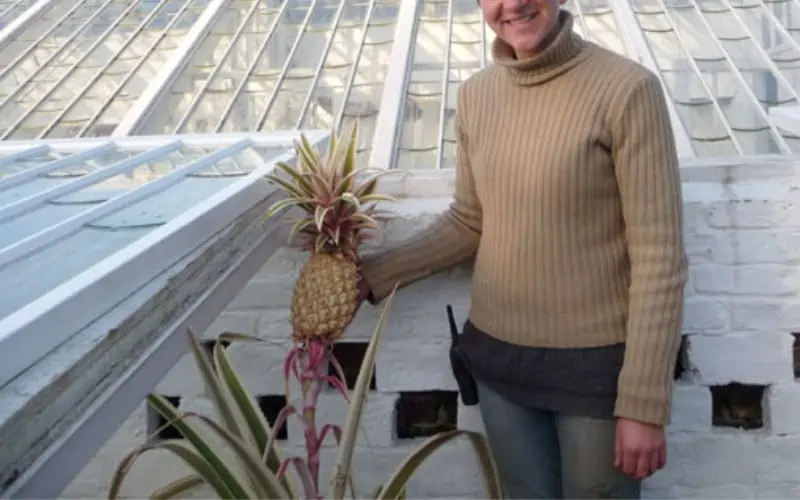
Having a menagerie of fresh fruit in your kitchen was once something that only the wealthiest could manage. Common fruits that we often take for granted, such as bananas, oranges, and pineapples, were once rare luxuries you’d never find in the average home.
But while several of these fruits are now affordable and accessible thanks to global trading and supermarkets, some remain distinctly expensive.
Take the Lost Gardens of Heligan Pineapple, for example. The price for one of these British pineapples is a staggering £1,000 (roughly $1,200). Well, it would be if they were for sale.
The Lost Garden of Heligan is a massive plant nursery and garden near Cornwall. Once lost to time, the estate has undergone massive renovations and restorations over the last few decades.
One of these restorations is a Victorian-era greenhouse and a slew of “pineapple pits.” The gardening team responsible for maintaining Heligan and its many plants has utilized Victorian-era techniques to ensure that all plants grow and appear as they would during that period.
This level of dedication means that hundreds of labor hours go into producing each of the estate’s pineapples, resulting in a final value that far exceeds the cost of the average supermarket fruit.
Why Is It So Expensive?
Low supply and high labor costs make these rare pineapples so valuable. Still, their value could exceed $1,200 if they ever go to auction, as owning a pineapple grown in a Victorian-era garden is sure to appeal to many buyers!
7. Taiyo no Tamago Mango – $3,725 Per Pair
When you think about mangoes, what do you picture? More than likely, you picture a round reddish-yellow fruit with sweet yellow insides that are cubed. But not all mangoes are tropical delights, and some look more like bright red ostrich eggs than fruit!
The Taiyo no Tamago Mango (also called Miyazaki Mango or Egg of the Sun) is one of the world’s most unique types of mangoes. Grown only in the Miyazaki Prefecture in Japan, this type of mango grows to an incredible size (350g/0.77lbs or more) and is an apple-red color.
In 2018, a pair of these mangoes sold at auction for an incredible $3,725. That works out to about $1,863 per fruit! Still, each bite of these sweet fruits might make the investment more than worth it.
For those hoping to host the most extravagant snacktime, why not also invest in some of the most expensive nuts? They’re bound to pair well with these mangoes!
Why Is It So Expensive?
As with many other high-priced fruits discussed throughout this ranking, exclusivity is one of the main reasons the Miyazaki Mango is so costly.
Only a select handful of these Japanese mangoes go to auction each year, and many fail to meet the qualifications to become Taiyo no Tamago mangoes. Those that do are immediately sought after by high-paying buyers, as these mangoes are massive and naturally rich in sugars, making them delicacies in their own right.
6. Black Densuke Watermelon – $6,100 Each
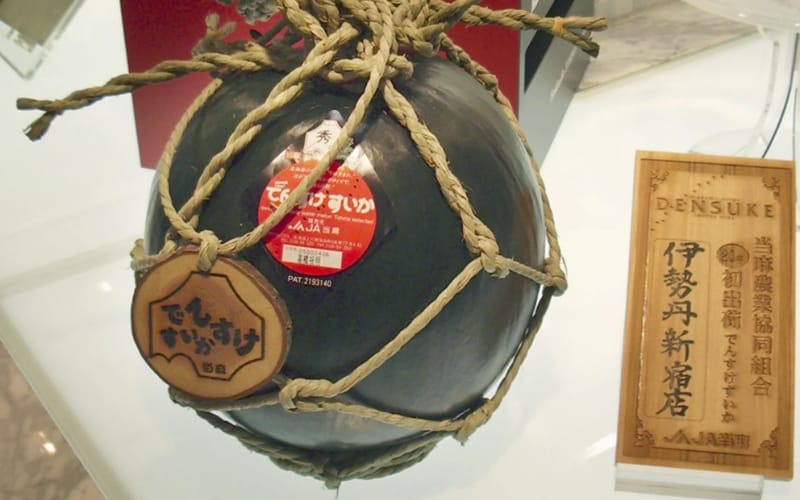
Upon first glance, you could easily mistake the Densuke Watermelon for a cannonball. This round, black fruit looks almost entirely unlike any other melon in the world, and for a good reason.
This dark melon only grows in Hokkaido, the second-largest island in Japan. Most are comparatively small when compared to standard US-grown watermelons. They’re also far more circular than the oblong watermelon those in North America are accustomed to.
Only a select few have ever tasted the inside of this easily recognizable melon. But those that have tasted the Black Densuke Watermelon say that the taste is entirely unique and beautifully sweet.
Are you interested in trying one of these watermelons for yourself? If so, expect to shell out thousands.
One of these melons sold for $6,100 in 2008! Of course, it was quite a hefty specimen, weighing in at an impressive 17lbs (7.7kg).
Why Is It So Expensive?
You’d probably have to travel to Hokkaido or one of Japan’s most affluent metropolitan areas to find a Dansuke Watermelon. These fruits are far rarer than standard watermelons, and their eye-catching look makes them a must-have for discerning diners.
Once again, supply and demand are primarily responsible for making these fruits so costly.
5. Tenka-Fubu Branded Persimmon – $7,500 Per Pair
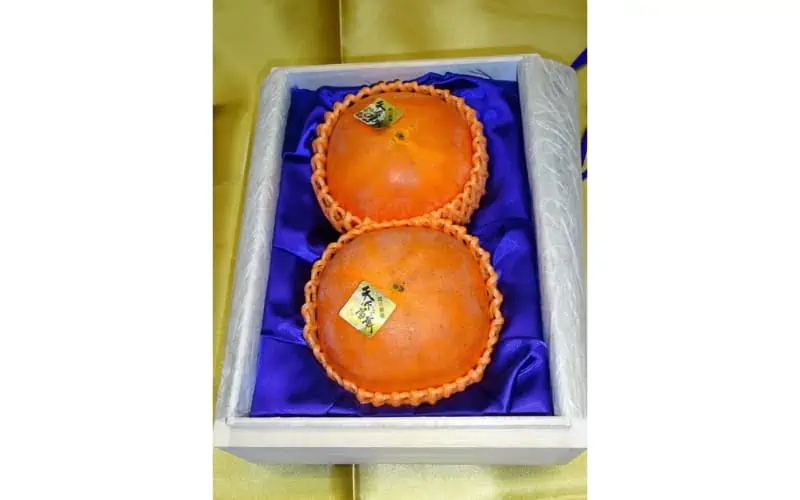
As you’ve likely noticed, Japan produces some of the most expensive fruits in the world. This includes the Tenka-Fubu Branded Persimmons.
Now, persimmons aren’t exactly one of the most popular fruits in North America. But they’re a staple throughout many Asian countries, so you’ll often find them in Korean and Japanese cuisine.
These orange-colored fruits come in many varieties, but the Tenka-Fubu Branded kind is the priciest. In 2021, a pair of these fruits (technically berries) sold for $7,500 at an auction in Toyoyama.
While many persimmons are prized for their sweetness, this pair was said to be unusually sweet, large, and absolutely flawless. Because they were so ideal, they were given the Tenkabito classification, something that most Tenka-Fubu Branded Persimmons fail to achieve.
Why Is It So Expensive?
Quality is why these persimmons sold for such a high price. Though thousands of Tenka-Fubu Branded Persimmons make their way throughout Japan yearly, only a few earn the Tenkabito classification.
Those rare few considered Tenkabito persimmons go to auction, where world-class chefs and wealthy persimmon consumers quickly bid on them. But because there might only be one or two Tenkabito persimmons per year, the supply is far below the demand, resulting in skyrocketing prices.
4. Ruby Roman Grapes – $11,000 Per Bunch
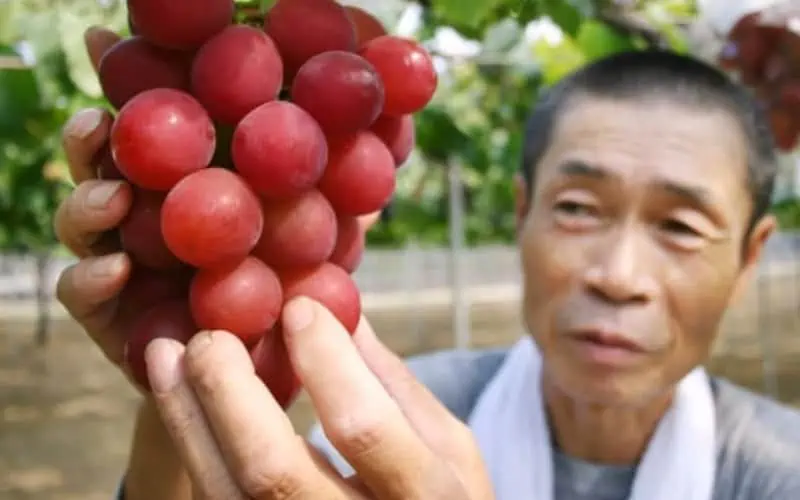
Despite the name of these fruits, Ruby Roman Grapes aren’t grown in Italy. Instead, they’re yet another Japanese fruit that can fetch jaw-dropping and mouthwatering prices.
Costing $11,000 per bunch, these large grapes (which look similar to cherries) are packed with natural sugars and are some of the least bitter types of grapes money can buy.
Of course, if you’d like a truly classical experience, it might be best to pair these grapes with a glass of some of the world’s most expensive milk!
Why Is It So Expensive?
Forced exclusivity makes these grapes such an expensive snack.
Few are grown in Japan, and only the best-looking and best-tasting ones go up for auction. While this ensures that the Ruby Roman Grape brand name remains untarnished, it also means that only the wealthiest buyers can enjoy them.
3. Premium Hokkaido Cantaloupe – $27,240 Per Pair
The Japanese island of Hokkaido produces some of the costliest produce on the planet. In addition to growing Black Densuke Watermelon, this island also grows cantaloupes that can sell for thousands apiece.
These melons, sometimes called Hokkaido Cantaloupe (because of where they’re grown), are larger than your typical grocery store cantaloupes. But that’s not the only reason they sell for big bucks.
A pair of premium-quality Hokkaido Cantaloupes sold for ¥3 million (about $27,240) in 2016, and the buyer attested that he was willing to spend so much as a show of appreciation to the farmers and agricultural workers of the island.
Why Is It So Expensive?
Japan takes its fruits very seriously.
While some chefs and restaurants throughout North America and Europe create decadent and complex dishes that sell for high prices due to rare or precious ingredients (edible gold shavings, white truffle oil), Japan’s most luxurious culinary offerings are often unusually large and tasty fruits.
So the main reasons these cantaloupes were worth a small fortune were probably quality and rarity, not to mention a cultural tendency to enjoy exceptional-quality locally-sourced fruit.
2. Yubari King Melon – $45,500 Per Pair
Speaking of expensive melons, have you ever heard of the Yubari King Melons? These massive cantaloupes, which are technically a hybrid creation, are similar to other high-priced Japanese fruits in several ways.
For example, they’re:
- Rich in natural sugars
- Unusually large as compared to standard varieties
- Sought after by Japan’s elite
But in 2019, the Yubari King Melons set a new record when a pair sold for ¥5 million (about $45,500). But why, exactly, did these melons fetch such a high price?
Why Is It So Expensive?
Japan’s fruit isn’t simply boxed and sold to local supermarkets.
Instead, the cultivators spend hundreds of hours classifying each fruit into a unique category based on its perceived quality. From there, the highest-quality produce is offered to wealthy buyers at auctions, while the lowest-quality produce is sold to food manufacturers or used to create compost.
The Yubari King Melons that sold for such an astounding price in 2019 were essentially perfect in every way. This level of perfection helped them sell for top dollar (or top yen) prices.
1. Rare Kanyao Durian – $47,990 Each
The most expensive fruit is the rare Kanyao (Kan Yao) Durian. Each of these spiky fruits costs $47,990 (originally 1.5 million Thai baht), making them about as expensive as a brand-new car.
But unlike most of the world’s costliest fruits, the Kanyao Durian doesn’t come from Japan! Instead, it hails from Thailand. And in 2019, it set a new Guinness World Record for the most expensive durian fruit after selling at auction for almost $50,000.
Durian is a slightly controversial fruit, as it’s said to be one of the smelliest fruits in the world. Many people have compared its smell to stinky feet or rotting meat. But while its smell might be off-putting, its taste is far more appealing.
This spiky fruit’s creamy, sweet innards are a delicacy, and the taste is often described as similar to fresh vanilla beans. But not all durian fruit is as costly as the infamous Kanyao Durian.
Only a handful of farmers cultivate this type of durian in Thailand. And most of these fruits aren’t “perfect” enough to sell for big bucks. But the one that sold for $47,990 in 2019 was a rare specimen, essentially ideal in all aspects, from size to ripeness.
Still, if you’re willing to get a run-of-the-mill Kanyao Durian, you could spend about $800 to $1,000 to reserve one for shipment.
Why Is It So Expensive?
Reputation is the primary reason Kanyao Durian is so expensive. This fruit has an international reputation for being one of the rarest fruits on the planet, and eating it is purported to impart several health benefits.
Those with deep pockets and educated palettes are often happy to spend thousands to enjoy this unique type of durian fruit. The smell, on the other hand, might not attract many wealthy bidders.
What Is the Most Expensive Fruit in the World?
So, what’s the most expensive fruit in the world? The answer is the rare Kanyao (also spelled Kan Yao) Durian. These spiky green fruits cost $47,990 apiece!
Although some durian fruit only costs a dollar or so per pound, Kanyao Durian is far pricier due to its rarity and reputation. There’s an astounding amount of demand for these yellow-fleshed fruits, but the supply is always far lower due to the low-yield nature of the Kanyao Durian tree.
Check out these related articles to discover more about the world’s most expensive foods.

